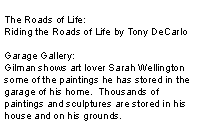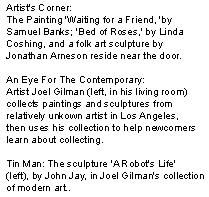


This avocation came to Gilman after a successful carrer in advertising provided him
with sufficient means to pursue his vision full time. Gilman is an artist whose own art
sells well and provides the creative satisfaction he felt was missing during his years
as an advertising art director. But it is his private collection of the emerging artists of
Los Angeles - a collection of more than 10,000 pieces, which both adorns his Beverly
Hills canyon home and fills his garage and other storage areas - that has become an
informal "classroom" for the uninitiated, a way for Gilman to share what he calls the
"joy of living with art. "Since nearly all the works he collects are from unknown artists,
and would have little value on the resale market, Gilman is quick to point out that he is
not making a profit from his collecting. When he does sell, "I'm recycling the art back
into the community, mostly in order to get money to buy more art," he says. "All this
art is very personal to me," says Gilman as he sweeps up the front steps past an
elaborate steel-wire sculpture that appears to be trying to scale his garden wall.
"Whenever I sell a piece, I feel as if I'm giving away a child. "He's been collecting
since he was 20. His first acquisition was a $100 abstract oil painting from a street
artist in London's Hyde Park. He even recalls the artist's name. "Graham Smithers,"
says Gilman with a smile, who adds that he has no idea what became of the artist.
The process of discovery is what got him hooked, says Gilman, who serves on the
board of directors of the Modern and Contemporary Art Council of the Los Angeles
County Museum of Art. "Part of my passion comes from the treasure hunt," he says.
He regularly visits university art programs as well as artists' studios. "I like to find
young artists." Gilman's home is alive with art, from the seven-foot sculpture of a man
in the entryway to the tiny figures crawling over walls on the living room table. A
detailed list of the items reveals 43 separate works of art in the living room, 26 works
in the kitchen, 17 in the master bathroom, 19 in the master bedroom, 4 in the powder
room, and an additional 17 in the guest bedroom. That doesn't include the dozens
scattered throughout the sitting room, atrium, hallways, and bathroom, as well as in
the gardens and patios. Gilman's approach to helping newcomers is a gentle
process of pushing boundaries. "He nudged me along in furthering my taste and
expanding my boundaries," says Mr. White, the new collector. "It was like I could
borrow his eyes for a while [to] help me look at color and texture in a new way."



 After an immersion process that can "pleasantly occupy a whole day," says White,
the two of them settled on a selection of artworks that would be installed in White's
beach cottage "for me to live with for a while, to see which ones I really like. "With
White's permission, Gilman emptied White's home of its current artworks. "It was a
hurricane of creative frenzy," White says. "He took apart my home and reassembled
it with all the pieces I had an eye for, not from the standpoint of an interior decorator,
but from an artistic one, with color, texture and feeling in mind. "White says his initial
intention, to buy one or possibly two new works, quickly changed. "The end result is
that I was really swept away, and I ended up with five new major pieces for my home,"
he says. Newcomers usually spend between $5,000 and $15,000 for their first
pieces, Gilman says. The emerging artists Gilman collects appreciate him as well,
as he helps introduce collectors to their work. "People like Joel are rare in the art
world," says Bruce Gray, an artist whose work Gilman owns. "He genuinely loves art
and artists, and he wants to see you succeed. "He's not in it for himself as much as
he is to help other artists further their work."
After an immersion process that can "pleasantly occupy a whole day," says White,
the two of them settled on a selection of artworks that would be installed in White's
beach cottage "for me to live with for a while, to see which ones I really like. "With
White's permission, Gilman emptied White's home of its current artworks. "It was a
hurricane of creative frenzy," White says. "He took apart my home and reassembled
it with all the pieces I had an eye for, not from the standpoint of an interior decorator,
but from an artistic one, with color, texture and feeling in mind. "White says his initial
intention, to buy one or possibly two new works, quickly changed. "The end result is
that I was really swept away, and I ended up with five new major pieces for my home,"
he says. Newcomers usually spend between $5,000 and $15,000 for their first
pieces, Gilman says. The emerging artists Gilman collects appreciate him as well,
as he helps introduce collectors to their work. "People like Joel are rare in the art
world," says Bruce Gray, an artist whose work Gilman owns. "He genuinely loves art
and artists, and he wants to see you succeed. "He's not in it for himself as much as
he is to help other artists further their work."
Tips for the emerging collector
Joel Gilman offers the following advice to art lovers who are just beginning to buy
works. Go with your instant gut reaction to an art work. Don't buy names, buy only
those items you absolutely love, and you can't go wrong. For those who say they
aren't confident about what they like in art, Gilman responds, "You know when you like
a dress or a shirt, don't you? Then, you know your tastes. Just trust them. "If you buy
anything under $5,000, don't do it with an eye for resale value. It probably won't have
any. Items over $5,000 you should consider as investment art and do research
beforehand on to their resale value. Don't worry about buying something that will look
good over your couch. Buy an artwork you love, then "travel it" through your house,
and you'll find the right place for it. An exception to the last statement: Large-scale
items, such as paintings over six feet or massive sculptures. You should bring these
items home to see if they work in your house before you commit to buying them.
Support young artists. For the price you might pay for a name artist, you could
probably find 10 equally interesting pieces by an emerging artist. If you have to return
five times to consider buying something, then it's not the piece for you.
VIEW
GILMAN STUDIO & ART COLLECTION






 After an immersion process that can "pleasantly occupy a whole day," says White,
the two of them settled on a selection of artworks that would be installed in White's
beach cottage "for me to live with for a while, to see which ones I really like. "With
White's permission, Gilman emptied White's home of its current artworks. "It was a
hurricane of creative frenzy," White says. "He took apart my home and reassembled
it with all the pieces I had an eye for, not from the standpoint of an interior decorator,
but from an artistic one, with color, texture and feeling in mind. "White says his initial
intention, to buy one or possibly two new works, quickly changed. "The end result is
that I was really swept away, and I ended up with five new major pieces for my home,"
he says. Newcomers usually spend between $5,000 and $15,000 for their first
pieces, Gilman says. The emerging artists Gilman collects appreciate him as well,
as he helps introduce collectors to their work. "People like Joel are rare in the art
world," says Bruce Gray, an artist whose work Gilman owns. "He genuinely loves art
and artists, and he wants to see you succeed. "He's not in it for himself as much as
he is to help other artists further their work."
After an immersion process that can "pleasantly occupy a whole day," says White,
the two of them settled on a selection of artworks that would be installed in White's
beach cottage "for me to live with for a while, to see which ones I really like. "With
White's permission, Gilman emptied White's home of its current artworks. "It was a
hurricane of creative frenzy," White says. "He took apart my home and reassembled
it with all the pieces I had an eye for, not from the standpoint of an interior decorator,
but from an artistic one, with color, texture and feeling in mind. "White says his initial
intention, to buy one or possibly two new works, quickly changed. "The end result is
that I was really swept away, and I ended up with five new major pieces for my home,"
he says. Newcomers usually spend between $5,000 and $15,000 for their first
pieces, Gilman says. The emerging artists Gilman collects appreciate him as well,
as he helps introduce collectors to their work. "People like Joel are rare in the art
world," says Bruce Gray, an artist whose work Gilman owns. "He genuinely loves art
and artists, and he wants to see you succeed. "He's not in it for himself as much as
he is to help other artists further their work."